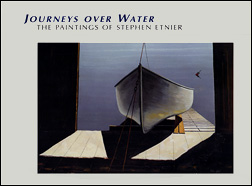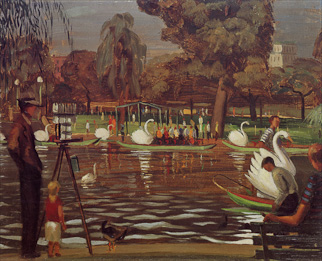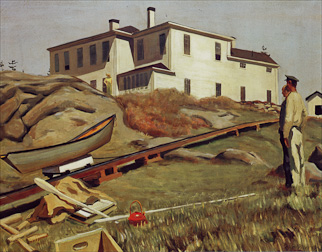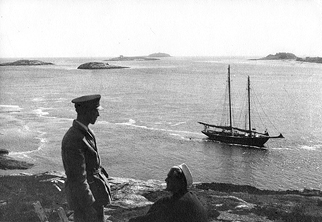 |
|||||||||||
|
|
|||||||||||
 |
|||||||||||
|
Journeys over Water
Essay for the 1998 exhibition catalog by Daniel. E. O'Leary, curator courtesy of Portland Museum of Art reproduced by permission. Presented in four parts: Introduction | I | II | III |
|||||||||||
|
I. Innocence: 1922 to 1941
Stephen Etnier was born to a privileged position in society and was groomed to manage his family's business. (5) Instead, Etnier created an independent identity for himself that was based on two goals: his ambition to achieve excellence as a painter and his desire to master the open sea. Stephen Etnier was impatient with authority and institutions, Each phase of his education at prep schools, at Yale University and Yale Art School, at Haverford College, at the Pennsylvania Academy of the Fine Arts, and during apprenticeships with Rockwell Kent and John Carroll was sporadic and incomplete. (6) His existence was self-directed. He learned from doing, rather than from listening. (7) His first paintings introduce Etnier's lifelong themes and interests: adventure, independence, travel, and fascination with the luminous effects of light on water. The early paintings show the influence of Rockwell Kent, John Sloan, and George Bellows. But Etnier gradually moved beyond emulation of other artists and embarked upon a search for subjects and techniques that met his own criteria. His paintings of the 1930s are replete with the details of his everyday life and are characterized by a mood of studied nonchalance. Boston Public Gardens provides a prime example of Etnier's first stylistic phase. The painting's broad brushstrokes and profuse colors indicate an interest in the techniques of Impressionism. Reflections of light and movement of water dominate the foreground. Etnier's delight in style, fashion, and social context is apparent. His early paintings are generally anecdotal and frequently represent informal social gatherings and idyllic situations. Etnier's work of the 1930s are period pieces that recall the playfulness of the films of Fred Astaire and the wholesomeness of the early movies of Jimmy Stewart. Etnier's paintings of the 1930s and 1940s record a vision of a simple and straightforward America. They are quaint commentaries on the norms, manners and pastimes of the artist's peers during this era of innocence. Etnier responds to coy and amusing situations that could serve as New Yorker magazine covers or illustrations for Esquire. (8) Illustrative, anecdotal, and peaceful, the early works resonate with charm and insouciance. Out for Repairs depicts the estate on Long Island at the mouth of the Kennebec River that the artist and his second wife, Elizabeth Morgan Etnier, acquired and began to restore in 1934. (9) The title of the painting refers to the dory that has been hauled up the tracks Etnier installed to lift objects and provisions to Gilbert Head from the water. (10) Stephen and Elizabeth first lived for two summers on their seventy-foot schooner, the Morgana, before succumbing to the temptation to own an island on the coast of Maine. (11) The works of the 1930s and 1940s employ reserved colors and are often dominated by subdued greens. The paintings suggest an ear of apparent stability and repose. Etnier's choices of subjects emphasize recreation, playfulness, and gentle diversions. Photographs of serene and epic views from Gilbert Head often functioned as the preliminary studies for these paintings. He chose to employ photographs that were rather formally and carefully organized. A photograph of the period shows Etnier's friend Ellison Moody wearing a first mate's cap, and an unidentified companion in a Coast Guard cap, at Gilbert Head, above the Morgana and framed by Sugarloaf Islands, Pond Island, and Seguin Island. Many of Etnier's early paintings used photographs of this stately prospect as their starting point to celebrate its splendor. The paintings of the Gilbert Head period represent Etnier's efforts to incorporate the inspiring panoramas of the area within the traditions of American landscape painting. Stephen Etnier's career during the 1930s and early 1940s was intimately tied to the coast of Maine and to Gilbert Head until it was interrupted by World War II.
|
|||||||||||
 |
|||||||||||
| Boston Public Gardens 1930s collection of William D Hamill |
|||||||||||
 |
|||||||||||
| Out for Repairs 1937 Collection of Gerald M. Amero |
|||||||||||
 |
|||||||||||